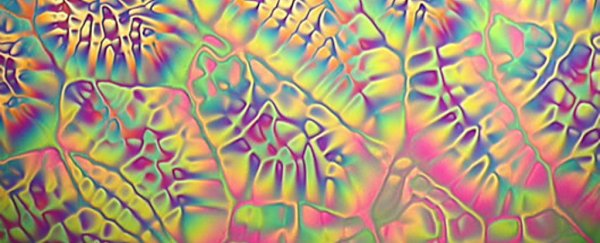Scientists have invented a new type of liquid crystal that allows tv and computer manufacturers to pack three times as many pixels into the same area of screen, while reducing the amount of power required to run the device.
This new type of blue-phase liquid crystal is so effective because it bypasses the colour filters used in current screen technology. This change alone reduces the amount of energy lost during light transmission by more than 40 percent.
"Today's Apple Retina displays have a resolution density of about 500 pixels per inch," says one of the team, physicist Shin-Tson Wu from University of Central Florida.
"With our new technology, a resolution density of 1,500 pixels per inch could be achieved on the same sized screen. This is especially attractive for virtual reality (VR) headsets or augmented reality technology, which must achieve high resolution in a small screen to look sharp when placed close to our eyes."
In today's LCD screens, a white LED backlight is modulated by a thin layer of nematic liquid crystal, which twists and untwists depending on how much voltage is applied.
Tiny transistors deliver enough voltage to transmit the LED backlight through each pixel in the screen, and colour filters are applied to generate red, green, and blue pixels.
The new blue-phase liquid crystal, which builds on old LCD technology from almost a decade ago, does away with these colour filters altogether because of how quickly it can control the colour changes.
According to Wu and his team, their blue-phase liquid crystal can be switched 10 times faster than the nematic type, which means in less than a millisecond, each LED colour can be sent through 'subpixels' of the crystal at different times.
Because one subpixel can make all three colours at any given moment, it means the technology can pack three times as many pixels into the same space as nematic liquid crystal displays.
"With colour filters, the red, green, and blue light are all generated at the same time," Wu explains.
"However, with blue-phase liquid crystal, we can use one subpixel to make all three colours, but at different times. This converts space into time, a space-saving configuration of two-thirds, which triples the resolution density."
The technology is still in the 'proof-of-concept' phase, but if it can be integrated in television and computer sceens, it will not only pack three times more pixels into the same amount of screen space, it will save power too, because it hasn't got any colour filters slowing down the process and interfering with the light transmission.
They report that colour filters can limit light transmittance - the amount of light absorbed by a substance - to around 30 percent, which means only 30 percent of the LED backlight is being absorbed in our screens at any given moment.
Their new liquid crystal, on the other hand, can reportedly achieve light transmittance of 74 percent, with an operation voltage of 15 volts per pixel.
Referring to their blue-phase liquid crystal display as a field-sequential colour display, the team says these perimeters make it practical for product development, and are working with manufacturers to make a prototype available in the next year or so.
If the technology lives up to its promise - and that's a big "if" when it comes to converting a proof-of-concept like this to something saleable - we can expect crazy-high resolution, which is something VR developers desperately need right now.
But let's not get our hopes up until we see these things on the market.
"Field-sequential colour displays can be used to achieve the smaller pixels needed to increase resolution density," says one of the team, Yuge Huang.
"This is important, because the resolution density of today's technology is almost at its limit."
The research has been published in Optical Materials Express.
